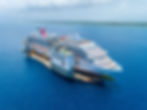Heavy lift: the ships that ship huge ships
- Sarah Whiteford
- Jul 30, 2021
- 4 min read
Let’s say you have a large vessel that needs to be transported, but not under its own power. I may be damaged or not yet seaworthy, what do you do? This is where heavy lift vessels come in, they can transport huge ships like cruise ships, war ships, and even container ships. They do it by submerging under the ship to be transported, then raising back up out of the water, similar to scooping a tennis ball out of the water if the tennis ball weighed tens of thousands of tons. We’ll take a look at a few of the largest semi-submersible heavy lift vessels in the world and their unique design that allows for such big transports.
The Blue Marlin
The Blue Marlin is one of the largest heavy lift ships, with a capacity of 75,000 tons. It’s owned by Dockwise (now Boskalis) and can transport cargo ships, aircraft carriers, and oil rigs. Famous lifts include the USS Cole destroyer after it was attacked in Yemen by an Al-Qaeda suicide bomber in 2000, as seen below. In 2003, Blue Marlin was upgraded for additional capacity and more maneuverability with two retractable propulsors. Shortly after, it took the Thunder Horse PDQ oil platform to Corpus Christi, Texas to be finished. In 2005, it moved the gas refinery Snøhvit from Spain to Norway over the course of 11 days, a feat that was featured by two TV shows: Discovery Channel’s Extreme Engineering and History Channel’s Mega Movers. The vessel is huge, measuring 712 feet long, 138 feet breadth, with a deck area of 120,850 square feet, the size of two soccer fields! Engines output 16,950 horsepower and the vessel can accommodate up to 55 people (Wikipedia). If all these impressive stats aren’t enough, multiply them by two, because the Blue Marlin has a sister ship built around the same time, the Black Marlin.

“The damaged destroyer USS Cole loaded aboard the heavy lift ship Blue Marlin, 2000 (USN file image)”. Image from The Maritime Executive.
BOKA Vanguard
If the job is really big, there’s only one ship to call, the BOKA Vanguard. It’s the largest semi-submersible heavy lift ship in the world, able to carry cargo up to 117,000 tons. According to ShipLilly, It was built at a cost of $240 million to move offshore oil and gas facilities and can even act as an offshore dry-dock for other large vessels when needed. Since it’s cheaper to build offshore facilities at the dock rather than on-site, growing rigs and platforms meant the need for a larger vessel to carry them. Dockwise worked with Deltamarin to design a “type-O heavy-lift vessel”, eventually named the Dockwise Vanguard. According to Wikipedia, the deck is 902 feet by 230 feet, for 207,460 square feet of space, 70% more than the Blue Marlin. It has 27,000 kW of power going to two propellers and two azimuth thrusters for precise movement. There is a bridge and living area on the starboard side, along with four buoyancy casings that are movable. Chevron’s Jack/St. Malo oil platform was the first cargo for the Vanguard, moving the 53,000 ton platform from Samsung Heavy Industries in South Korea to the Gulf of Mexico. It has also acted as a dry dock multiple times, including in 2019 for the Carnival Cruise ship Carnival Vista. It was loaded on the Vanguard in Freeport, Bahamas and taken to Grand Bahama Shipyard to complete repairs. The transport, repairs to the ship’s azipods, and refloat only took about 12 hours. Dockwise was looking into building an even larger vessel in 2014, but none has been created yet.

Carnival Vista onboard the Boskalis Vanguard in transit to be repaired at Grand Bahama Shipyard. Image from gCaptain.
So how exactly do these vessels lift ships?
All three of the ships we’ve discussed are semi-submersible heavy lift vessels. Since they are semi-submersible, vessels like the BOKA Vanguard fill ballast tanks to lower the deck of the vessel underwater. According to Wikipedia, the deck is watertight and going under poses no risk to the vessel. Fully flooded, the deck sinks to 52 feet under the surface, allowing for deep draught ships like a cruise ship to float above the transport vessel. The ballast tanks are then emptied and the Vanguard’s deck rises above the water, lifting the cruise ship out of the water. It’s a unique design that means no cranes or other lifting mechanisms are needed to lift a ship that otherwise may even be too heavy. Refloating is just as easy, simply fill the ballast tanks and the ship being transported is again floating and can be moved away from the transport vessel. This type of lift minimizes the risks that would otherwise go with moving large vessels. One of the reasons the Vanguard was used as a dry dock for Carnival Vista is because a crane at the Grand Bahama Shipyard fell on Royal Caribbean’s Oasis of the Seas, closing down one of the dry docks, according to the Independent.
These are three of the largest semi-submersible heavy lift vessels in the world with a very cool method for performing heavy lifts. We highly recommend checking out the video below showing how the Carnival Vista was dry docked on the BOKA Vanguard.
BOKA Vanguard dry docking Carnival Visa. Video from Royal Boskalis Westminster N.V. on YouTube.
Happy Friday!
Sources: